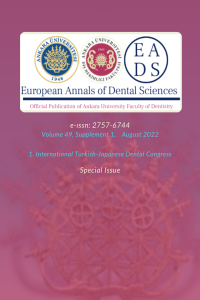Abstract
References
- 1. Marshall RI, Bartold PM: A clinical review of drug-induced gingival overgrowths. Australian Dental Journal 1999;44:219–32.
- 2. Informational Paper:Drug-Associated Gingival Enlargement. Journal of Periodontology 2004;75:1424–31.
- 3. Kurgan Ş, Önder C, Tayman A, Koçi A, Bostancı H: Kalsiyum kanal blokörü (amlodipin) kullanımına bağlı dişeti büyümesi: 5 yıl takipli vaka raporu. Atatürk Üniversitesi Diş Hekimliği Fakültesi Dergisi 2016;26:307-311.
- 4. Hallmon WW, Rossmann JA: The role of drugs in the pathogenesis of gingival overgrowth. A collective review of current concepts. Periodontology 2000 1999;21:176–96.
- 5. Seymour RA, Thomason JM, Ellis JS: The pathogenesis of drug-induced gingival overgrowth. Journal of Clinical Periodontology 1996;23:165–75.
- 6. Seymour RA, Ellis JS, Thomason JM, Monkman S, Idle JR: Amlodipine-induced gingival overgrowth. Journal of Clinical Periodontology 1994;21:281–3.
- 7. Ellis JS, Seymour RA, Steele JG, Robertson P, Butler TJ, Thomason JM: Prevalence of Gingival Overgrowth Induced by Calcium Channel Blockers: A Community-Based Study. Journal of Periodontology 1999;70:63–7.
- 8. Pihlstrom BL, Carlson JF, Smith QT, Bastien SA, Keenan KM: Prevention of Phenytoin Associated Gingival Enlargement—A 15-Month Longitudinal Study. Journal of Periodontology 1980;51:311–7.
- 9. Hancock RH, Swan RH: Nifedipine-induced gingival overgrowth. Journal of Clinical Periodontology 1992;19:12–4.
- 10. Hall EE: Prevention and treatment considerations in patients with drug-induced gingival enlargement. Current Opinion in Periodontology 1997;4:59-63.
Abstract
Aim: A common side effect of calcium channel blockers, which are frequently used in the treatment of patients with hypertension and cardiovascular problems, is that they can cause overgrowth in gingiva. Gingival overgrowths should be treated because they create inaccessible areas, making oral hygiene practices difficult due to increased plaque retention. In this case series, clinical properties of gingival overgrowths deriving from the usage of amlodipine, which is a type of calcium channel blockers and its treatment protocols are explained.
Methods: Three male patients aged 15, 60 and 45 applied to our clinic with the complaints of gingival overgrowth and bleeding. In the anamnesis, it was learned that they were using antihypertensive medication containing amlodipine. In the first session, scaling and root planning applications were performed. Then, the patients who were given detailed oral hygiene instructions, consulted with the relevant physicians. It was deemed appropriate to replace the drug the patients were using with another antihypertensive drug, which is an alternative that does not lead to gingival overgrowth. After the controls performed at certain time intervals and oral hygiene evaluations, it was observed that a perfect recovery was achieved. In addition to these, gingivoplasty was performed using classic surgical method under local anesthesia on one case.
Results: All three patients showed uneventful healing without any complications. During periodic controls, it was observed that patients’ complaints disappeared, the gingiva regained their natural physiological form, aesthetically pleasing results were achieved, no recurrences were observed in the 6th month and periodontal health could be maintained.
Conclusion: The treatment protocol for gingival overgrowth due to drug use includes the replacement or discontinuation of the current drug with an alternative drug with the physician's consultation, after the initial periodontal treatment and oral hygiene practices, periodontal surgical procedures and regular controls in severe cases.
References
- 1. Marshall RI, Bartold PM: A clinical review of drug-induced gingival overgrowths. Australian Dental Journal 1999;44:219–32.
- 2. Informational Paper:Drug-Associated Gingival Enlargement. Journal of Periodontology 2004;75:1424–31.
- 3. Kurgan Ş, Önder C, Tayman A, Koçi A, Bostancı H: Kalsiyum kanal blokörü (amlodipin) kullanımına bağlı dişeti büyümesi: 5 yıl takipli vaka raporu. Atatürk Üniversitesi Diş Hekimliği Fakültesi Dergisi 2016;26:307-311.
- 4. Hallmon WW, Rossmann JA: The role of drugs in the pathogenesis of gingival overgrowth. A collective review of current concepts. Periodontology 2000 1999;21:176–96.
- 5. Seymour RA, Thomason JM, Ellis JS: The pathogenesis of drug-induced gingival overgrowth. Journal of Clinical Periodontology 1996;23:165–75.
- 6. Seymour RA, Ellis JS, Thomason JM, Monkman S, Idle JR: Amlodipine-induced gingival overgrowth. Journal of Clinical Periodontology 1994;21:281–3.
- 7. Ellis JS, Seymour RA, Steele JG, Robertson P, Butler TJ, Thomason JM: Prevalence of Gingival Overgrowth Induced by Calcium Channel Blockers: A Community-Based Study. Journal of Periodontology 1999;70:63–7.
- 8. Pihlstrom BL, Carlson JF, Smith QT, Bastien SA, Keenan KM: Prevention of Phenytoin Associated Gingival Enlargement—A 15-Month Longitudinal Study. Journal of Periodontology 1980;51:311–7.
- 9. Hancock RH, Swan RH: Nifedipine-induced gingival overgrowth. Journal of Clinical Periodontology 1992;19:12–4.
- 10. Hall EE: Prevention and treatment considerations in patients with drug-induced gingival enlargement. Current Opinion in Periodontology 1997;4:59-63.
Details
| Primary Language | English |
|---|---|
| Subjects | Dentistry |
| Journal Section | Conference Papers |
| Authors | |
| Publication Date | August 31, 2022 |
| Submission Date | July 2, 2021 |
| Published in Issue | Year 2022 Volume: 49 Issue: Suppl 1 |


